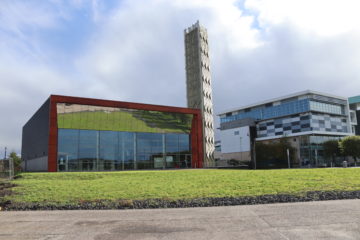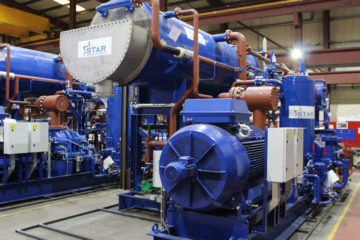Heatpumps to play a key role in tackling climate change – Scottish Government Energy Plan

Ahead of the Scottish Government’s draft climate change plan which is expected to highlight the role heat pumps will play in meeting the country’s carbon targets and tackling social injustice, The BBC talked to Dave Pearson, director of Star Renewable Energy about how can we use rivers to heat our homes.
The interviews and BBCs visit to Star manufacturing facilities in Glasgow were broadcast on BBC radio Scotland this morning and will be shown again this evening on the 6.00 o’clock news on BBC One.
You can find the feature right here, and on the BBC’s website.
For more information on Drammen’s Heatpump as featured on the BBC and how it was used to warm a whole city from the ice-cold waters of a local fjord, read on:
Star Renewable’s groundbreaking sustainable heating system is heating homes, hospitals, libraries and businesses across an entire city in Norway.
Heat pumps are becoming increasingly popular across Europe as the heat they deliver far exceeds the energy they consume. District heating sees heat generated in a centralised location distributed for residential and commercial heating.
By 2009, the Norwegian city of Drammen’s population had grown to such a degree that its existing district heating system could not cope. While researching ways to expand its capacity, the city’s heating company Drammen Fjernvarme, led by Jon Ivar Bakk, discovered the water temperature in the fjord was ideal for heat pumps.
Star Renewable Energy stood out amongst other bidders during the tender process, despite having no prior experience of water based heat pumps. The Glasgow based company is best known for providing refrigeration systems to some of the UK’s biggest retailers, including Tesco and ASDA. As director Dave Pearson says, “we were the new kids on the block but we’ve always had a reputation for pushing boundaries.”
District heat pumps already exist in Scandinavia and across Eastern and Central Europe, providing higher efficiencies than traditional localised boilers. However, many of these first generation systems rely on hydrofluorocarbon (HFC) refrigerants, which are thousands of times more potent as global warming gases than carbon dioxide when emitted to the atmosphere. HFCs are currently being phased out by the EU under the Montreal Protocol.
Hence, Star’s selling point was simple – while other companies were using hydrofluorocarbons (HFCs) as the coolant, Star proposed using ammonia, a naturally occurring refrigerant which has zero ozone depletion potential. Ammonia has never been used in a high temperature heat pump allocation of this type. Electricity for the Drammen system is provided by hydropower, making the Neatpump’s carbon emissions virtually zero.
Star’s Neatpump is a renewable energy heat pump that extracts heat from seawater, air or any industrial waste stream, such as large scale cooling processes. This waste heat is captured, compressed, boosted and recycled to provide hot water at up to 90oC for heating buildings on a massive scale. The project was completed in January 2011, and has since delivered over 350GWh of heat for the Drammen community of 60,000 people. It is the world’s largest district-wide natural heat pump system.
And if it works in Drammen, it can work anywhere where there is a constant supply of water, standing or flowing.
In the UK, Star is already working with local housing associations in Glasgow and is speaking with a dozen city councils including Newcastle, Durham, Manchester and Stoke. It is also working on projects in Zurich and the South of France, and bidding for a system in Belgrade. The potential is huge – for example, the Thames could generate 1.25GW of capacity, enough to heat 500,000 homes.
Dave Pearson says: “Systems such as the Neatpump could literally revolutionise the way we heat factories, hospitals, office buildings, data centres, even entire communities across the globe. The technology behind it is so advanced that it can even be configured to deliver district wide air conditioning, with waste heat providing the energy to drive desalination processes for producing fresh drinking water.”
He adds: “At present, a shocking amount of heat generated through cooling processes worldwide is simply discarded as waste to the atmosphere. Organisations could now be recycling waste heat from their process, air conditioning and IT cooling systems and boosting it for use in their own and neighbouring buildings.”
Star’s heat pumps have been providing Drammen district heating with 85% of the hot water needed to heat the city. “We are very happy with it,” says Jon Ivar, CEO of Drammen Fjernvarme AS. “Having already paid for itself, and with savings to date of around €10m and 75,000 tonnes of carbon, it’s not hard to see why.”
Star’s renewable district heat pump technology has won a number of awards over the years, including the prestigious Rittinger Medal from the International Environmental Agency. This year Star’s heatpumps have been nominated twice for the top National ACR and Heat Pump Awards 2017. The two shortlisted heatpump projects are for a recent Water Source Heat Pump installation, which is being used to supply heat and hot water to one of the largest town’s district heating schemes in the country and for an Air Source Heat Pump, which aims to reduce fuel poverty for seven existing high-rise blocks -a total of 350 social homes- in Hillpark Drive, Glasgow.
Star has invested heavily in zero carbon technology and continues to develop new products to provide energy conscious systems for the benefit of customers and the environment.
Star focuses on the design, manufacture, installation, commissioning and aftercare of industrial refrigeration and HVAC (heating, ventilation and air conditioning) systems.


